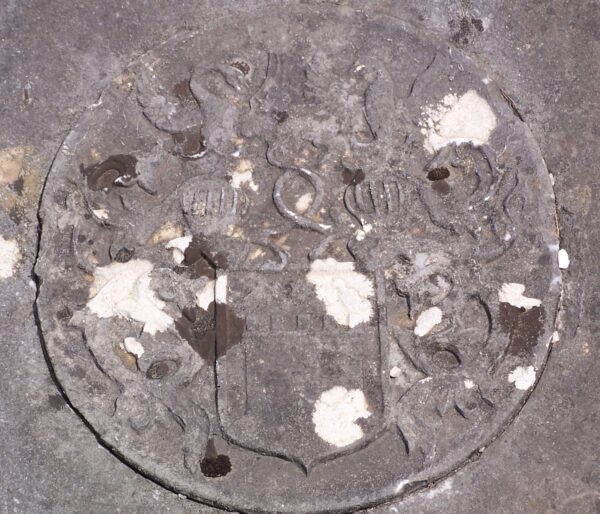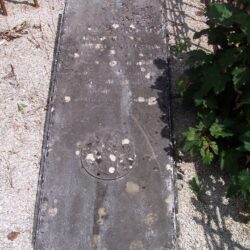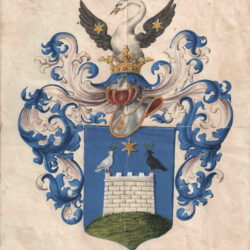
Coat of arms of the Langer-Podgoro family in Šmihel pri Novem Mestu
NOVO MESTO, ŠMIHEL, CEMETERY
Location of the coat of arms: tombstone
The origin of the Langers, one of the most famous noble Lower Carniolan families in the nineteenth and twentieth centuries, remains shrouded in mystery. Even the Langers themselves knew nothing about the family from which Franz Xaver (1765–1811), the first (demonstrable) Langer in Carniola, descended from. As his great-granddaughter Matilda (1862–1939) noted in her memoirs, perhaps Franz Xaver had wanted his lineage to remain a secret. It is even assumed that he was the illegitimate son of Count Auersperg from Križ (Germ. Kreuz), who provided him with excellent education and secured him a good standing in society. First documented in the last quarter of the eighteenth century as the administrator of the Auersperg seigniory of Križ near Komenda, Franz Xaver Langer initiated his social ascension by purchasing Poganice Manor (Germ. Poganitz, modern Pogance) near Novo Mesto in 1791 and asserting his position among Lower Carniolan castellans. In the following years, he brought the abandoned and neglected manor back to life, which in 1808 earned him membership in the Carniolan provincial estates; however, under the condition that he request hereditary knighthood. His aspirations were cut short by the French occupation of Carniola.
Following Franz Xaver’s death, the only heir to Poganice (together with the pertaining estate in Bršljin) was his only and minor son Franz Heinrich (1794–1861). In his will, Franz Xaver expressed a desire for his son to keep the manor and take up office in state administration. Heeding his father’s wish, Franz Heinrich completed grammar school in Graz and continued his education by pursuing law studies in Vienna. After graduating, he returned to Lower Carniola, took over his father’s estate, and entered civil service in Novo Mesto. In 1842, he was transferred to Ljubljana and, suffering from hearing loss, retired five years later at his own request.
Four years before his death, Franz Heinrich finally achieved ennoblement for himself and his family after his father’s aspirations were dashed by the French wars and after his uncle Vinzenz von Klosenau, acting as his guardian, unsuccessfully requested the emperor to grant his protégé a title of nobility in 1816. No earlier than 1857, the emperor finally heard Langer’s request and granted him nobility based on his and his father’s “still unrewarded merit.” Franz Heinrich also requested the predicate with the name Poganitz; however, his request was denied because the name had already been used by the Barons Gussich (Slovenianized: Gusič) as the former castellans of Poganice. The accepted proposal was Podgoro, with which the Langers obtained a purely Slovenian predicate. Sixteen years later, Franz Heinrich’s son Franz Victor (1830–1895) received the third-class Imperial Order of the Iron Crown and climbed another rung on the nobility ladder by also obtaining the rank of knighthood. The predicate remained unchanged as did the coat of arms, except that, instead of one, the knightly coat of arms features two helmets above the escutcheon.
This version has also been preserved on the Langer family’s grave plaque in Šmihel Cemetery near Novo Mesto. The coat of arms depicts a round tower with a pair of pigeons perched on it, facing each other and holding an olive branch in their beaks.
Sources:
Rugále, Mariano in Preinfalk, Miha: Blagoslovljeni in prekleti. 2. del: Po sledeh mlajših plemiških rodbine na Slovenskem. Ljubljana: Viharnik, 2012, pp. 84–91.


